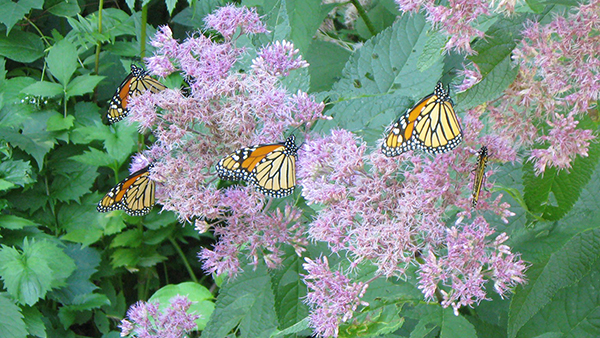
Each year the National Garden Bureau chooses a bulb, annual, perennial, edible, and shrub to be featured in its “Year of the” program to draw attention to unique plants and varieties gardeners should consider. The year 2021 marks the Year of the Hardy Hibiscus, a die-back perennial that is gaining popularity throughout the Northern Plains as a way to add a dash of tropical flavor to your landscape.
While it is similar to its tropical cousin (Hibiscus rosa-sinensis, Zones 9–11) that many of us may grow as a houseplant, hardy hibiscus is able to withstand temperatures as low as –30°F, as it is primarily a hybrid of two North American natives: swamp rose mallow (H. moscheutos, Zones 5–9) and smooth rose mallow (H. laevis, Zones 4–9).
Hardy hibiscus can appear shrublike, but it primarily performs as a die-back perennial that is often slow to wake up in the spring, sometimes convincing Northern Plains gardeners that the plant died the previous winter. However, once the soil warms and the plants begin to grow in late May to early June, you will soon be greeted by a plant that grows an inch a day and matures to 5 to 6 feet or taller by late summer, covered in tropical-looking blooms the size of dinner plates.
To grow hardy hibiscus successfully, choose a site that is in full sun, receives consistent moisture, and has enough room for the plant to grow. Because it wakes up so slowly in spring, consider planting it with spring-blooming bulbs that will be fading just as hardy hibiscus awakens. Before you know it, you too will be asked by stunned onlookers if that really is a tropical hibiscus growing in your garden!
Here are some great varieties of hardy hibiscus to consider for your Northern Plains garden.

‘Summer Storm’ hardy hibiscus
H. ‘Perfect Storm’, Zones 4–9
‘Summer Storm’ hardy hibiscus boasts 8- to 10-inch rosy pink flowers atop deep purple foliage that reaches 4 to 6 feet tall and wide.

‘Luna Rose’ hardy hibiscus
H. moscheutos ‘Luna Rose’, Zones 5–9
This dwarf hardy hibiscus also comes in white, pink, and red colors, with 6- to 8-inch flowers on 2- to 3-foot-tall and -wide plants.

‘Jazzberry Jam’ hardy hibiscus
H. ‘Jazzberry Jam’, Zones 4–9
‘Jazzberry Jam’ hardy hibiscus dazzles with 9-inch-wide deep magenta flowers that have slightly ruffled petals on large 4- to 5-foot-tall by 6- to 7-foot-wide plants.

‘Evening Rose’ hardy hibiscus
H. ‘Evening Rose’, Zones 4–9
‘Evening Rose’ hardy hibiscus is coming to garden centers in 2021, featuring 8-inch wide, puckered, hot pink flowers on nearly black foliage that grows 4 to 5 feet tall and wide.
Consider jumping on the bandwagon by adding one or more of these hardy hibiscus varieties to your Northern Plains gardens to create a feeling of warm sandy beaches and lofty palm trees without leaving home, or at least without going farther than the garden center.
—Chris Schlenker is horticulture and grounds manager at McCrory Gardens of South Dakota State University in Brookings, South Dakota.


















Comments
Log in or create an account to post a comment.
Sign up Log in